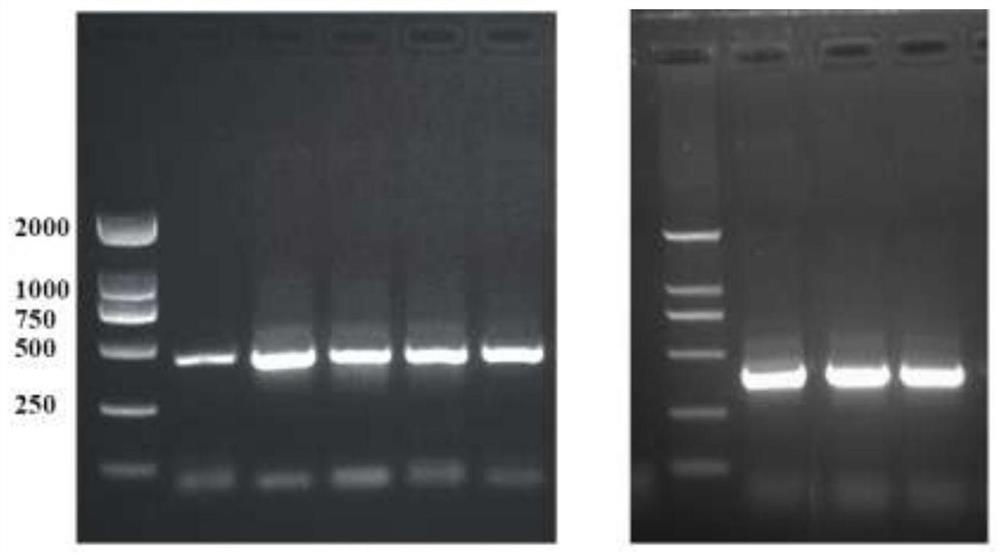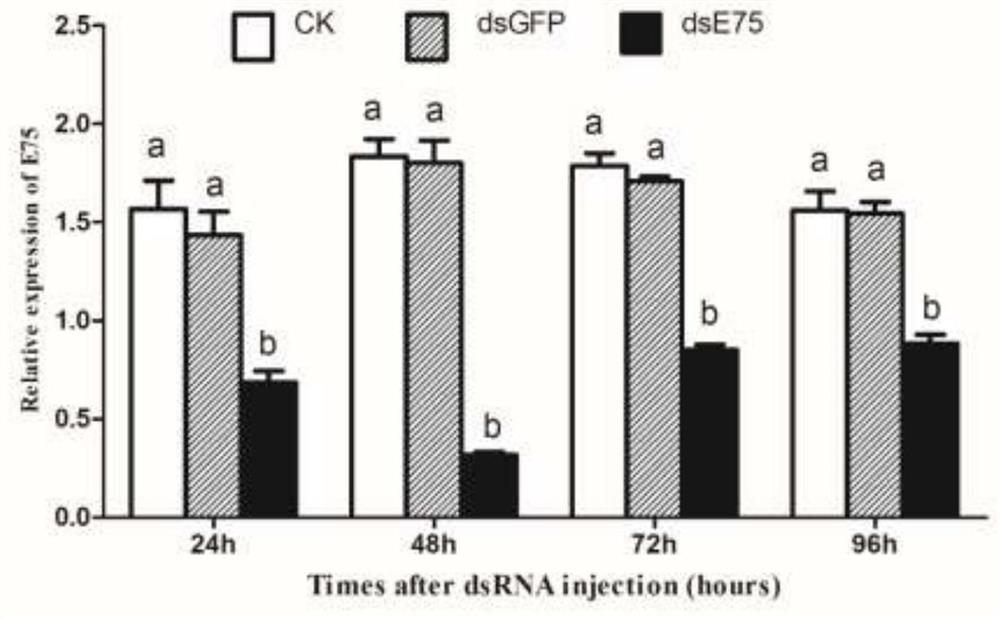Cotton bollworm e75 gene and its application in RNA-mediated pest control
A cotton bollworm and gene technology, applied in the direction of DNA/RNA fragments, application, genetic engineering, etc., can solve the problems of increased resistance and aggravated damage of transgenic Bt cotton, achieving high prospective, low risk of resistance, and reduced The effect of pupation rate
- Summary
- Abstract
- Description
- Claims
- Application Information
AI Technical Summary
Problems solved by technology
Method used
Image
Examples
Embodiment 1
[0043] Example 1 Obtaining the cDNA sequence of the cotton bollworm E75 gene
[0044] 1. Extraction of total RNA of cotton bollworm
[0045] The whole process of total RNA extraction of cotton bollworm is carried out in a sterile operating table, and the reagents and consumables used are RNAase-free. The specific steps are as follows:
[0046] 1) Collect fresh cotton bollworm tissue, then add it to a sterile tissue grinder frozen with liquid nitrogen, quickly add 1 ml of Trizol reagent, fully grind the tissue, and then use an RNase-free pipette tip to transfer the homogenate to a sterile tissue grinder. After centrifugation in a 1.5ml centrifuge tube of RNAase, let stand in an ice bath for 5-10min; the speed of the centrifuge tube is 12000rpm, the temperature is 4°C, and the centrifugation time is 10min;
[0047] 2) Transfer the centrifuged supernatant (about 900 μl) in step 3) to a new RNase-free centrifuge tube;
[0048] 3) Add 200 μl of chloroform to the supernatant of th...
Embodiment 2
[0055] Example 2 Cloning of E75 gene target fragment of Helicoverpa armigera and preparation of dsRNA
[0056] I. Design specific primers
[0057] According to the characteristics of the E75 gene, the gene fragments in the DNA binding region of the gene were selected, and their effects on insects were studied by injection method. The DNA binding region is an important region that regulates the transcription of insect hormone nuclear receptors and plays an important role in the regulation of insect hormones. , so this target sequence was selected to observe the effect of the gene silencing on the development and metamorphosis of cotton bollworm; the selected control gene was the green fluorescent protein GFP gene. Since the GFP gene does not exist in insects, a large number of studies have used it as a control. Gene synthesis of dsRNA;
[0058] Use Primer Premier 5.0 software to design specific primers with reference to the design principles of RNA primers. The designed specif...
Embodiment 3
[0068] Example 3 Verification that E75-dsRNA of Helicoverpa armigera inhibits the metamorphosis of Helicoverpa armigera
[0069] 1. Microinjection of dsRNA of the E75 gene of Helicoverpa armigera
[0070] Helicobacter bollworm larvae of 5 instars and 1d, of uniform size and the same health status were selected, and the control group injected with dsGFP and the experimental group injected with dsE75 were set up. The abdominal intersegmental membrane between the 8th and 9th sections was injected into the body cavity of the cotton bollworm larvae. The injection volume of dsRNA was 10 μg / head, and each group was injected with 90 heads, and 3 biological replicates were set. Cotton bollworm larvae were raised in 12-well plates with artificial feed;
[0071] 2. Detection of gene silencing effect of cotton bollworm E75
[0072] Within 0-96 hours after dsRNA injection, samples were taken every 24 hours for gene silencing effect detection. Four heads were taken from the control group ...
PUM
 Login to View More
Login to View More Abstract
Description
Claims
Application Information
 Login to View More
Login to View More - R&D
- Intellectual Property
- Life Sciences
- Materials
- Tech Scout
- Unparalleled Data Quality
- Higher Quality Content
- 60% Fewer Hallucinations
Browse by: Latest US Patents, China's latest patents, Technical Efficacy Thesaurus, Application Domain, Technology Topic, Popular Technical Reports.
© 2025 PatSnap. All rights reserved.Legal|Privacy policy|Modern Slavery Act Transparency Statement|Sitemap|About US| Contact US: help@patsnap.com



